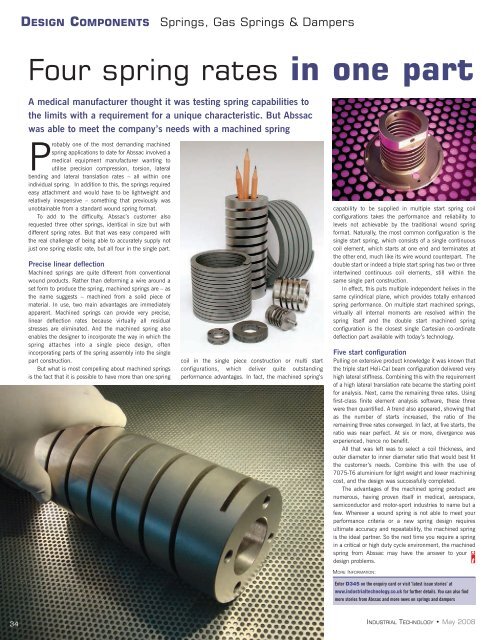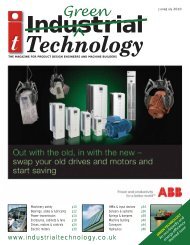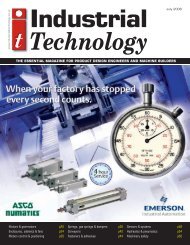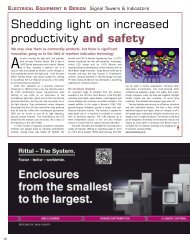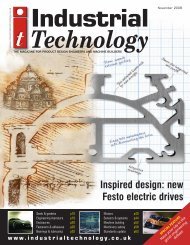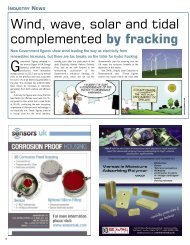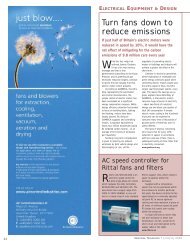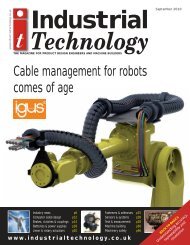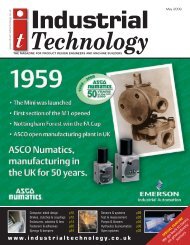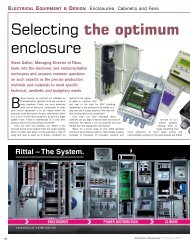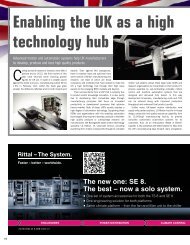sensors & systems - Industrial Technology Magazine
sensors & systems - Industrial Technology Magazine
sensors & systems - Industrial Technology Magazine
Create successful ePaper yourself
Turn your PDF publications into a flip-book with our unique Google optimized e-Paper software.
DESIGN COMPONENTS<br />
Springs, Gas Springs & Dampers<br />
Four spring rates in one part<br />
A medical manufacturer thought it was testing spring capabilities to<br />
the limits with a requirement for a unique characteristic. But Abssac<br />
was able to meet the company’s needs with a machined spring<br />
Probably one of the most demanding machined<br />
spring applications to date for Abssac involved a<br />
medical equipment manufacturer wanting to<br />
utilise precision compression, torsion, lateral<br />
bending and lateral translation rates – all within one<br />
individual spring. In addition to this, the springs required<br />
easy attachment and would have to be lightweight and<br />
relatively inexpensive – something that previously was<br />
unobtainable from a standard wound spring format.<br />
To add to the difficulty, Abssac’s customer also<br />
requested three other springs, identical in size but with<br />
different spring rates. But that was easy compared with<br />
the real challenge of being able to accurately supply not<br />
just one spring elastic rate, but all four in the single part.<br />
Precise linear deflection<br />
Machined springs are quite different from conventional<br />
wound products. Rather than deforming a wire around a<br />
set form to produce the spring, machined springs are – as<br />
the name suggests – machined from a solid piece of<br />
material. In use, two main advantages are immediately<br />
apparent. Machined springs can provide very precise,<br />
linear deflection rates because virtually all residual<br />
stresses are eliminated. And the machined spring also<br />
enables the designer to incorporate the way in which the<br />
spring attaches into a single piece design, often<br />
incorporating parts of the spring assembly into the single<br />
part construction.<br />
But what is most compelling about machined springs<br />
is the fact that it is possible to have more than one spring<br />
coil in the single piece construction or multi start<br />
configurations, which deliver quite outstanding<br />
performance advantages. In fact, the machined spring’s<br />
capability to be supplied in multiple start spring coil<br />
configurations takes the performance and reliability to<br />
levels not achievable by the traditional wound spring<br />
format. Naturally, the most common configuration is the<br />
single start spring, which consists of a single continuous<br />
coil element, which starts at one end and terminates at<br />
the other end, much like its wire wound counterpart. The<br />
double start or indeed a triple start spring has two or three<br />
intertwined continuous coil elements, still within the<br />
same single part construction.<br />
In effect, this puts multiple independent helixes in the<br />
same cylindrical plane, which provides totally enhanced<br />
spring performance. On multiple start machined springs,<br />
virtually all internal moments are resolved within the<br />
spring itself and the double start machined spring<br />
configuration is the closest single Cartesian co-ordinate<br />
deflection part available with today’s technology.<br />
Five start configuration<br />
Pulling on extensive product knowledge it was known that<br />
the triple start Heli-Cal beam configuration delivered very<br />
high lateral stiffness. Combining this with the requirement<br />
of a high lateral translation rate became the starting point<br />
for analysis. Next, came the remaining three rates. Using<br />
first-class finite element analysis software, these three<br />
were then quantified. A trend also appeared, showing that<br />
as the number of starts increased, the ratio of the<br />
remaining three rates converged. In fact, at five starts, the<br />
ratio was near perfect. At six or more, divergence was<br />
experienced, hence no benefit.<br />
All that was left was to select a coil thickness, and<br />
outer diameter to inner diameter ratio that would best fit<br />
the customer’s needs. Combine this with the use of<br />
7075-T6 aluminium for light weight and lower machining<br />
cost, and the design was successfully completed.<br />
The advantages of the machined spring product are<br />
numerous, having proven itself in medical, aerospace,<br />
semiconductor and motor-sport industries to name but a<br />
few. Wherever a wound spring is not able to meet your<br />
performance criteria or a new spring design requires<br />
ultimate accuracy and repeatability, the machined spring<br />
is the ideal partner. So the next time you require a spring<br />
in a critical or high duty cycle environment, the machined<br />
spring from Abssac may have the answer to your<br />
design problems.<br />
MORE INFORMATION:<br />
Enter D345 on the enquiry card or visit ‘latest issue stories’ at<br />
www.industrialtechnology.co.uk for further details. You can also find<br />
more stories from Abssac and more news on springs and dampers<br />
34<br />
INDUSTRIAL TECHNOLOGY • May 2008


